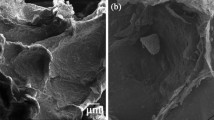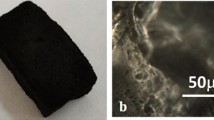Abstract
Carboxymethyl cellulose (CMC)/sodium alginate (SA) hydrogel beads were successfully prepared by Ca2+ ions crosslinking followed by gamma irradiation. The factors affecting beads formation are the composition of SA in the blend and concentration of calcium chloride as a crosslinking agent. The results indicated that the addition of CMC to SA increases the swelling (%) upto (1:3) (CMC:SA) ratio. The effect of different irradiation doses (2.5, 5, and 10 kGy) on swelling (%) was studied. At low doses, swelling (%) decreases upto 5 kGy then starts to increase at 10 kGy. The degree of the swelling (%) and release (%) of ammonium nitrate salt from beads were investigated under different pH (1.2, 5 and 7). The beads were characterized by FTIR, SEM and TGA to investigate molecular structure, morphology and thermal stability of beads.








Similar content being viewed by others
References
Chavidi VP, Bala YS, Chanda LNR, Kokkarachedu VP, Posa S, Subha MCS (2012) Formulation and characterization of sodium alginate g-hydroxy ethylacrylate bio-degradable polymeric beads: in vitro release studies. J Polym Environ 20:344–350
Shukla PG, Kalidhass B, Snah A, Palaskar DV (2002) Preparation and characterization of microcapsules of water-soluble pesticide monocrotophos using polyurethane as carrier material. J Microencapsul 19:293–304
Bajpai AK, Giri A (2003) Water sorption behavior of highly swelling (carboxy methylcellulose-g-polyacrylamide) hydrogels and release of potassium nitrate as agrochemical. Carbohydr Polym 53:271–279
Peppas NA, Bures P, Leobandung W, Ichikawa H (2000) Hydrogels in pharmaceutical formulations. Eur J Pharm Biopharm 50:27–46
Rehab A, Akelah A, Kandil S (1994) Modification of poly(methyl methacrylate)resins with herbicide moities. J Appl Polym Set Appl Polym Symp 55:185–196
Yang Y, He Q, Duan L, Cui Y, Li JB (2007) Assembled alginate/chitosan nanotubes for biological application. Biomaterials 28:3083–3090
Kim IY, Seo SJ, Moon HS, Yoo MK, Park IY, Kim BC, Cho CS (2008) Chitosan and its derivatives for tissue engineering applications. Biotechnol Adv 26:1–21
Shi GQ, Chen YW, Wan CX, Yu XX, Feng T, Ding YL (2008) Study on the preparation of chitosan–alginate complex membrane and the effects on adhesion and activation of endothelial cells. Appl Surf Sci 255:422–425
Li ZS, Ramay HR, Hauch KD, Xiao DM, Zhang MQ (2005) Chitosan-alginate hybrid scaffolds for bone tissue engineering. Biomaterials 26:3919–3928
Capela P, Hay TKC, Shah NP (2007) Effect of homogenisation on bead size and survival of encapsulated probiotic bacteria. Food Res Int 40:1261–1269
Johnson FA, Craig DQM, Mercer AD (1997) Characterization of the block structure and molecular weight of sodium alginates. J Pharm Pharmacol 49:639–643
Liu XX, Qian LY, Shu T, Tong Z (2003) Rheology characterization of sol–gel transition in aqueous alginate solutions induced by calcium cations through in situ release. Polym 44:407–412
Yellanki SK, Nerella NK (2010) Stomach-specific drug delivery of riboflavin using floating alginate beads. Int J Pharmacy Pharm Sci 2:160–163
Grassi M, Colombo I, Lapasin R (2001) Experimental determination of the theophylline diffusion coefficient in swollen sodium-alginate membranes. J Cont Rel 76:93–105
Kim MH, Kim JC, Lee HY, Kim JD, Yang JH (2005) Release property of temperature-sensitive alginate beads containing poly(N-isopropylacrylamide). Coll Surf B 46:57–61
Xu YM, Zhan CY, Fan LL, Wang L, Zheng H (2007) Alginate chitosan blend gel beads and in vitro controlled release in oral site-specific drug delivery systems. Int J Pharm 336:329–337
Stabler C, Wilks K, Sambains A, Constantinidis I (2001) The effects of alginate composition on encapsulated bTC3 cells. Biomaterials 22:1301–1310
Rokhade AP, Agnihotri SA, Patil SA, Mallikarjuna NN, Kulkarni PV, Aminabhavi TM (2006) Semi-interpenetrating polymer network microspheres of gelatin and sodium carboxymethyl cellulose for controlled release of ketorolac tromethamine. Carbohydr Polym 65:243–249
Liu Z, Jiao Y, Wang Y, Zhou C, Zhang Z (2008) Polysaccharides-based nanoparticles as drug delivery systems. Adv Drug Deliv Rev 60:1650–1657
Jo H, Kim DS, Hong MS, Kim HL, Cho WH, Lee D, Khang G (2011) Influence of the viscosity properties on drug release rate from hydroxymethylcellulose and carboxymethylcellulose matrix tablets. Int J Tiss Regen 2:21–28
Bajpai J, Mishra S, Bajpai AK (2007) Dynamics of controlled release of potassium nitrate from a highly swelling binary polymeric blend of alginate and carboxymethyl cellulose. J Appl Polym Sci 106:961–972
Tanzina H, Avik K, Dominic D, Stephane S, Ruhul AK, Monique L (2012) Effect of gamma radiation on the physico-chemical properties of alginate-based films and beads. Rad Phys Chem 81:945–948
Salmieri S, Lacroix M (2006) Physicochemical properties of alginate/polycaprolactone-based films containing essential oils. J Agric Food Chem 54:10205–10214
Bajpai AK, Shrivastava M (2002) Enhanced water sorption of a semi-interpentrating polymer network of poly (2-hydroxyethyl methacrylate) and poly (ethylene glycol). J Macromol Sci Pure Appl Chem A 39:667–672
Johnsen K, Kirkhorn S, Olafsen K, Redford K, Stori A (1996) Modification of polyolefin surfaces by plasma-induced grafting. J Appl Polym Sci 59:1651–1657
Author information
Authors and Affiliations
Corresponding author
Rights and permissions
About this article
Cite this article
Ibrahim, S.M., Abou El Fadl, F.I. & El-Naggar, A.A. Preparation and characterization of crosslinked alginate–CMC beads for controlled release of nitrate salt. J Radioanal Nucl Chem 299, 1531–1537 (2014). https://doi.org/10.1007/s10967-013-2820-4
Received:
Published:
Issue Date:
DOI: https://doi.org/10.1007/s10967-013-2820-4




